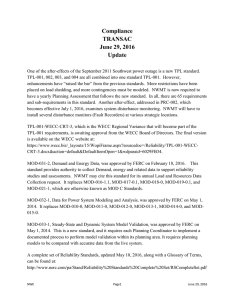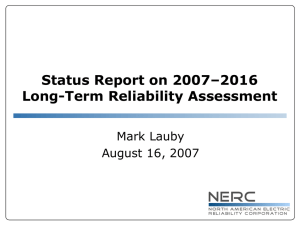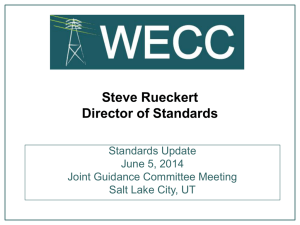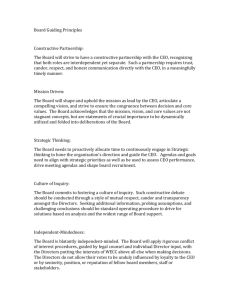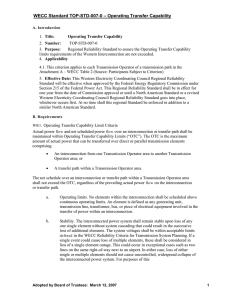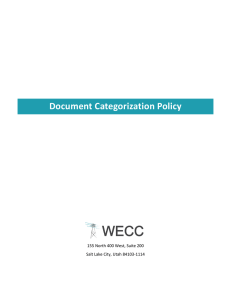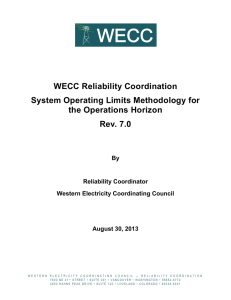WECC LMTF current priorities 1-12-2016
advertisement
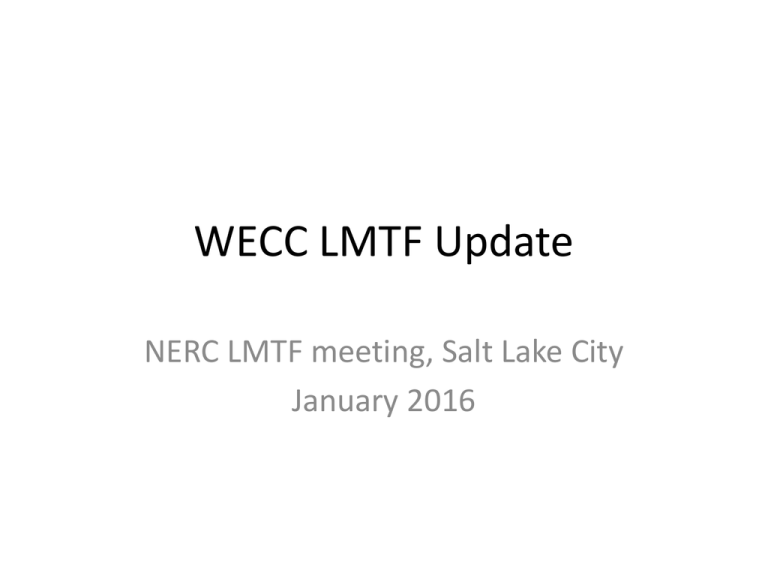
WECC LMTF Update NERC LMTF meeting, Salt Lake City January 2016 Why it Matters • The load model has a major impact on oscillation damping • The load model has a major impact on FIDVR • A significant amount of load loss can occur due to end-user tripping • Loads are becoming less grid-friendly (more power electronics) • Distributed generation is increasing History of Load Modeling (in WECC) • Analysis of August 1996 disturbance showed that a dynamic load model was needed to better capture inter area oscillations History of Load Modeling (in WECC) • 2002 – WECC “Interim” Load Model 20% induction motor (MOTORW), remaining static load Was intended to be temporary fix Model limitations were recognized and need for a better model was clear • In August 2000, another disturbance occurred • Analysis showed that even the 20% induction motor was not adequate to represent oscillation damping August 4th, 2000 disturbance 546 544 542 540 538 536 534 532 530 528 526 524 0 5 10 Voltage Actual 15 20 25 Simulations - Conentional 30 35 40 Simulations - Composite Load Model 45 50 WECC Load Modeling Task Force • 2002 – WECC develops the Load Model Task Force • 2005 – WECC developed ‘explicit’ model Added distribution equivalent Modeled induction motor and static loads Numerical stability in Interconnection-wide study o This was a big step … 10 years ago … still unavailable in the East … • 2007 – First version of the composite load model in PSLF Three phase motor models only, no single phase represented • 2006-2009 – EPRI/BPA/SCE testing residential air conditioners and developing models • 2009 – single phase air conditioner model added to composite load model • 2013 – WECC approved use of CMPLDW phase 1 model for planning and operational studies The CMPLDW Model Recent Work • June 2015 meeting Building Survey: Motor Protection and Control (Kueck, James, PNNL) Single Phase AC performance testing (Bernie, Dmitry) 3ph and 1ph motor analysis (John Undrill) Model Validation o Idaho Power event (Eric Bakie) o Southern California Edision event (Jun Wen) Efficient data management • November 2015 meeting MEPPI sensitivity study Phase 2 roadmap discussion Porting CLM to WSM cases (breaker node model) Update to WECC voltage dip criteria Future Vision • 1-2 years Consistent, robust rules for initialization (phase 1 and phase 2) Efficient data management Improved Protection Modeling Load Model Data tool development Benchmarking between software programs (phase 1 and 2) • 2-5 years Component Model Flexibility (Plug and Play Capability) Improved Air Conditioner Models Updates to Distributed Solar Generation and Energy Storage Models Model Validation studies • 5-10 years Collecting and Coordinating load model data Adopt CLM for steady state studies • 10+ years Promote CLM as standard load model for bulk grid studies (IEEE wide) Current Priorities • • • • Priority 1: Robust initialization rules Priority 2: Improved Protection Modeling Priority 3: Efficient Data management Priority 4: Benchmarking between programs Full Work Plan Coordination with NERC LMTF • Need to expand user base Educational Webinars and Workshops • Develop data sets for different regions • Expand model validation studies • Develop industry wide knowledge of impact of dynamic load modeling • Distribution/Load modeling will become more important for bulk grid studies of the future
